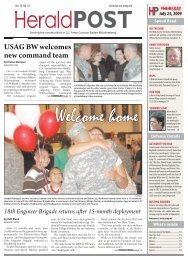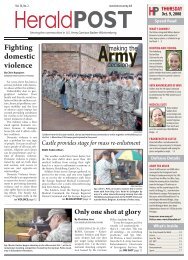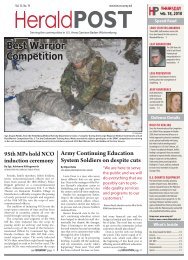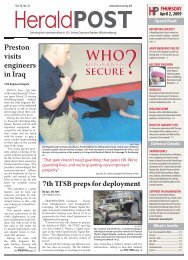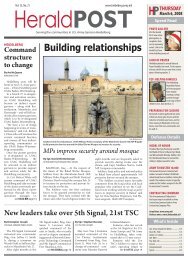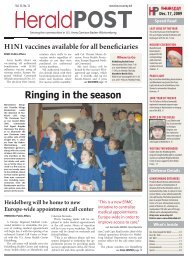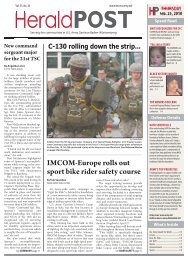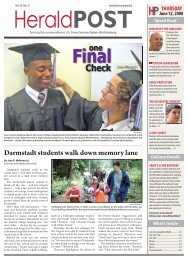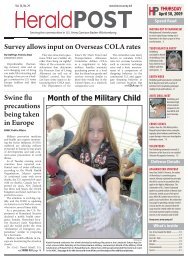Herald Post 2009-10-01.pdf
Herald Post 2009-10-01.pdf
Herald Post 2009-10-01.pdf
Create successful ePaper yourself
Turn your PDF publications into a flip-book with our unique Google optimized e-Paper software.
HP<br />
Thursday, Oct. 1, <strong>2009</strong><br />
NEWS<br />
15<br />
Sgt. Fay Conroy<br />
Pvt. Shalice Mosby, a rigger with the 5th Quartermaster Company,<br />
21st Special Troops Battalion, practices attaching the Firefly<br />
Joint Precision Air Delivery System to a load during a new equipment<br />
training course held at Rhine Ordnance Barracks Sept. 18.<br />
The 5th QM Company was the first regular Army unit to train on<br />
the Firefly JPADS.<br />
Precision air delivery<br />
5th QM is first Army unit to train on new system<br />
By Sgt. Fay Conroy<br />
21ST TSC PUBLIC AFFAIRS<br />
The 5th Quartermaster Company,<br />
21st Special Troops Battalion<br />
became the first regular<br />
Army unit to train on the 2,200-<br />
pound load-carrying capable<br />
Firefly Joint Precision Air Delivery<br />
System Sept. 7-18.<br />
The 2K Firefly JPADS allows<br />
more accurate air drops into remote<br />
areas and provides a better<br />
covert approach for the delivery<br />
aircraft.<br />
“This particular system has<br />
been in development for five or<br />
six years,” said Chief Warrant<br />
Officer 4 Bobby Davis, who was<br />
representing the Aerial Delivery<br />
and Field Services Division of<br />
the U.S. Army Quartermaster<br />
Corps Center and School. “It<br />
was developed from a radioguided<br />
system, which is now a<br />
GPS-guided system. You can put<br />
in the grid coordinates to the<br />
destination you want it to impact,<br />
and once you log the grid<br />
destination in there it gives the<br />
aircraft the ability to fly offset to<br />
the drop zone.”<br />
The 2K Firefly is able to carry<br />
up to 2,200 pounds, and the<br />
point of impact ranges from<br />
50-150 meters to the grid point<br />
based on the weight of the load<br />
it is carrying, Davis said.<br />
According to information provided<br />
by the developer of the 2K<br />
Firefly, users of the system only<br />
need to input the location of the<br />
impact point and the weight of<br />
the load.<br />
The system reads the wind<br />
and flight data automatically<br />
several times a second to make<br />
continual adjustments to its<br />
flight path, so it can land on the<br />
correct coordinates.<br />
In addition to it being more<br />
accurate, the system also makes<br />
it easier for those on the receiving<br />
end.<br />
“You can pinpoint where you<br />
want it to go, which makes it<br />
easier for the person receiving<br />
it,” said Sgt. Todd Harrell a rigger<br />
with the 5th QM Company.<br />
“They don’t have to search for<br />
it.”<br />
During the two-week training<br />
course, the riggers learned how<br />
to properly lay out the system,<br />
how to pack it up, how to attach<br />
it to the load, and how to program<br />
it. After taking a test, the<br />
riggers were certified to use the<br />
system for their air drops.<br />
Schedule DA<br />
photos online<br />
7th Army JMTC Public Affairs<br />
GRAFENWÖHR, Germany –<br />
Starting today, Soldiers in Europe<br />
can schedule their official DA<br />
Photography appointments online,<br />
as directed by Headquarters,<br />
Department of the Army.<br />
The new, Web-based Visual Information<br />
Ordering Site, www.<br />
vios.army.mil, allows Soldiers to<br />
schedule DA photos, location<br />
photography, graphic and video<br />
production, presentation support<br />
services, media and equipment<br />
loan electronically.<br />
Area Training Support Centers<br />
have enabled VIOS and the online<br />
appointment calendar, to streamline<br />
the scheduling process by automatically<br />
de-conflicting the Soldiers<br />
requested appointment and<br />
submitting the work order online,<br />
eliminating the need to call the local<br />
TSC to submit a manual work<br />
order on DA Form 3903.<br />
The VIOS software application<br />
requires Common Access Card<br />
authentication, and allows more<br />
efficient work-order tracking and<br />
provides Soldiers the ability to<br />
schedule an appointment anywhere,<br />
at anytime, when they have<br />
access to a military computer.<br />
For more information on accessing<br />
VIOS, contact your local<br />
TSC by calling your DSN prefix<br />
and -1398, or by contacting the<br />
JMTC’s visual information manager<br />
at DSN 475-6558.<br />
Troops arrive at exercise site, begin setup<br />
of life support area for Natural Fire <strong>10</strong><br />
By Spc. Jason H. Nolte<br />
21ST TSC PUBLIC AFFAIRS<br />
Spc. Jason H. Nolte<br />
A member of the Ugandan Peoples Defense Force informs Master Sgt. Jonathan Bailey, a contracting agent<br />
with the 405th Army Field Support Brigade, of the time remaining on the journey, while Maj. Richardo Wilson,<br />
the plans and operations officer for the 21st Special Troops Battalion, issues instruction to the joint<br />
forces at a gas station on the road from Kampala to Gulu Sept. 25.<br />
KITGUM,Uganda – A joint<br />
force of U.S.Soldiers and Sailors,<br />
escorted by members of<br />
the Ugandan Peoples Defense<br />
Force, headed north out of<br />
Entebbe toward Kitgum, the<br />
site of Natural Fire <strong>10</strong>.<br />
This marks one of the first<br />
partnership efforts in the<br />
multilateral exercise, which<br />
offers an opportunity for<br />
east African partner nations<br />
and the U.S. military to work<br />
together to increase regional<br />
capabilities to respond to<br />
complex humanitarian emergencies.<br />
Military personnel from<br />
Burundi, Kenya, Rwanda,<br />
Tanzania, Uganda and the<br />
United States will participate<br />
in this year’s exercise.<br />
The military escort cut<br />
quickly through the capital<br />
traffic of Kampala, speeding<br />
the U.S. forces on their way.<br />
Outside the capital the traffic<br />
fell off considerably, and the<br />
vehicles were only slowed by<br />
the occasional speed bump<br />
or poor road conditions. At<br />
the crossing of the Nile, the<br />
line of vehicles stopped for a<br />
brief photo opportunity.<br />
“They knew their job,” said<br />
Sgt. Ezekiel Kibet, a maintenance<br />
supervisor with<br />
the Germany-based 317th<br />
Maintenance Company,<br />
391st Combat Sustainment<br />
Support Battalion, 16th Sustainment<br />
Brigade, who was<br />
pleased with the escort.“They<br />
knew exactly what they were<br />
doing. They’re pretty friendly,<br />
ready to learn, and ready<br />
to help.”<br />
After crossing the Nile, the<br />
busses slowed slightly as they<br />
passed a nature reserve to allow<br />
baboons to walk across<br />
the road. The road deteriorated<br />
slightly north of the<br />
nature reserve as another<br />
major route branched off,<br />
and dodging potholes occasionally<br />
forced the busses to<br />
follow the escort onto the dirt<br />
shoulder.<br />
At the town of Gulu, the<br />
busses stopped at an inn<br />
for a brief break and to fill<br />
up on water. The town of<br />
Gulu also marked the end of<br />
paved roads, but the journey<br />
north continued, now on<br />
hard-packed dirt. But unlike<br />
most dirt roads in the United<br />
States, these dirt roads are<br />
well travelled.They are two<br />
lanes wide and often show<br />
the effects of the most recent<br />
rains.<br />
“From Gulu to Kitgum it<br />
was a little bit dusty, a little bit<br />
rough, but it was OK,” Kibet<br />
said. “At least we were able to<br />
make it and be on time.”<br />
After a night of rest, the<br />
Soldiers and Sailors immediately<br />
began onsite preparations<br />
for the life support area<br />
for Natural Fire <strong>10</strong>. The LSA<br />
is a temporary living area<br />
where the U.S. forces participating<br />
in the multilateral exercise<br />
will reside.




